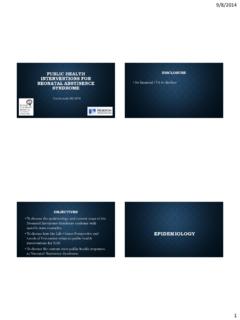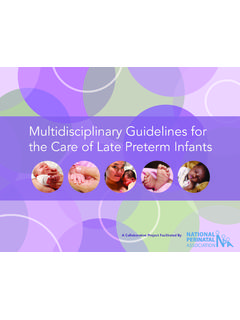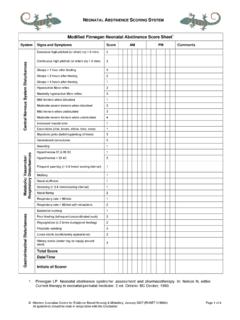Transcription of Objectives What is NAS? - National Perinatal Association
1 1 Providing Optimal Care for Neonates with neonatal abstinence SyndromebyKaren D Apolito, , APRN, NNP-BC, FAANP rofessor & Program Director, NNP SpecialtyVanderbilt University School of NursingFaculty DisclosureI have no affiliation with any of the drug companies that produce the medications I will be am the developer of the inter-observer reliability program for the Finnegan Scoring ) Describe the incidence of NAS in the US and hospital costs2) Identify drugs associated with NAS. 3) Describe the appropriate way to assess neonates for signs of NAS. 4) Identify non-pharmacologic, pharmacologic and caregiving strategies for managing neonates with is NAS?Also known as neonatal Withdrawal SyndromeConstellation of behavioral and physiologic signs caused by cessation of exposure to licit and illicit , 2010 what is NAS?Two types: Maternal use during pregnancy Postnatal use (fetanyl, morphine)Hamdan, 2010 what is NAS?
2 Causes alterations in functioning: CNS disturbances Metabolic, vasomotor, Respiratory Disturbances Gastro-Intestinal DisturbancesFinnegan, et al, 19752 Drugs Associated with NASO pioids: HeroinMethadoneFentanylMorphine DemerolOxyContinNonopioid CNS Depressants May present with some or mimic symptoms ofNAS Benzodiazepines SSRI s Barbiturates Anticonvulsants Antipsychotics AlcoholEpidemic of Prescription Opiate Use/AbusePrescription drug abuse is a growing National epidemic. Addiction, overdoses and deaths involving non-medical prescription drug use have risen significantly over the last decade. Hansen et al. 2011 Epidemic of Prescription Opiate Use/AbuseIn 2006 the estimated total cost in the United States of nonmedical use of prescription opioids was $ billion $42 billion was attributable to lost productivity, $ billion to criminal justice costs $ billion to drug abuse treatment $944 million to medical et al.
3 2011 Opiate Pain Relievers (OPR s)Deaths from OPR s: increased 5 fold between 1999 and 2010 for women have died each year from drug overdoses than from motor vehicle 2010 enough OPR s were prescribed to medicate every adult in US with a typical dose of 5 mg of hydrocodone taken every 4 hours for 1 MMWR, July 5, 2013 Illicit Drug Use In Pregnancy (2011) pregnant - pregnant women 18 to 25 years - overall (less than non-pregnant ) Use of Opiates per 1,000 Hospital BirthsPatrick, 2012 3 Magnitude of Problem Estimated that 13,500 babies are born each year with NAS from non-iatrogenic causes in 2009 One baby born each hour in the US with signs of neonatal et al, 2012 Cost of Care2000 - $190 million2009 - $720 million5 fold # women using opioids during pregnancy3 fold in babies diagnoses with NASP atrick et al, 2012 Reported LOS8-79 days with average of 30 daysLOS is varied because optimal treatment for NAS has not been identified60-80% of these babies will require pharmacologic managementLangenfeld, et al, 2005; Lainwala et al, 2005; Jackson et al, 2004.
4 Sarkar & Dunn, 2006 NAS in Tennessee10 fold increase between 2000 2010 TennCare represents a cost of times more than a baby without NAS in 2010 Infants in TennCare system are 18 times more likely to enter state custody than infants without of Health, Tennessee Dr Michael Warren Slides from NAS reporting webinar March 19, 2013 Ohio StatisticsMassatti, R., et al., 20134 TennesseeExposure Over Time OhioMassatti, R., et al., 2013 Frequency of NAS50-80% of heroin exposed infants develop NAS60-90% of methadone and buprenorphine exposed infants develop NAS50-75% of infants with NAS will require pharmacologic managementPresentationDepends upon: Type of drug Additional Substances Timing of maternal dose Infant metabolism Gestational age and birth weight Genetics????Hudak, 2012 Detection and ScreeningTesting for drug exposure: UrineObtain as soon as possible after birthHigh false-negative (up to 60%) rate because only reports recent drug exposure MeconiumBetter than urineDrug exposure from 16 weeks GAOstrea, 20015 Detection and ScreeningHair Analysis: Radio immunoassay Grows 1 cm/month Metabolite present for life of hair Tells you drug use for months Gets into microfibrils Can use neonatal hairOstrea, 2001 Detection and ScreeningUmbilical Cord 10 cm section of cord at delivery Rise with sterile saline Place in sterile container ELISA based test Information.
5 Et al, 2008 Compared to MeconiumDrugUCAmphetamineAgreement 97%Sensitivity 95%OpiatesAgreement 95%Specificity 96%Sensitivity - 78%Montgomery, et al, 2005 Compared to MeconiumDrugUCCocaineAgreement 99%Specificity 100%Sensitivity 75%CannabinoidsAgreement 91%Specificity 91%Sensitivity 89%Montgomery, et al, 2005 Detection and ScreeningMaternal history History of drug use Methadone treatment (high dose does not mean infant will have NAS) Family history of drug abuse Prior involvement with CPS Incarceration for drug abuse Clancy et al, 2010 Detection and ScreeningDifferential Diagnosis: Infection Hypocalcemia Hypomagnesemia Hyperthyroidism Hypoglycemia CNS injuryHamdan, et., al, 20126 Detection and ScreeningAssess infant for signs of withdrawal Central Nervous System Excitability Gastrointestinal Dysfunction Autonomic signsHamdan et.
6 , al, 2012 Drugs Associated with NAS Opioids: HeroinMethadoneFentanylMorphine DemerolOxyContinNonopioid CNS Depressants Benzodiazepines Antidepressants (SSRI s) Barbiturates Anticonvulsants Antipsychotics AlcoholCommon Signs of NASP hysiologicAlcoholMarijuana BarbSneezing--XStuffy Nose---Spitting/drooling ---DiarrheaX --VomitingX --Poor FeedingX --SweatingX--TachypneaX--Tachycardia ---Neurobehavioral Alcohol Marijuana BarbituratesFist sucking---IrritabilityXXXR estlessness--XTre mo r sX -XHigh-pitched cryX --Seizures X --Ya w n i n g---Disturbed sleep-XXIncreased crying--XConvulsions--XHypertonicityX --Drowsiness---Increased sleep---Common Signs of NASP hysiologicSSRIC ocaineMethSneezing ---Stuffy Nose---Spitting ---Diarrhea ---Vomiting---Poor XXXfeedingSweating
7 ---Tachypnea---Tachycardia---Neurobehavi oral SSRI Cocaine MethamFist sucking ---IrritabilityX--RestlessnessX--Tre mo r sX--High-pitched cry ---Seizures X --Ya w n i n g---Disturbed sleep X --Increased cryingX--Convulsion X--HypertonicityX --Drowsiness-XXIncreased sleep-XX 7 TobaccoLinked to: LBW infants Prematurity Placental Abruption Intrauterine Death SIDSS alihu and Wilson, 2007 Signs of Tobacco ExposureExcitabilityIncreased muscle toneMore handling to be calmedIncreased suckingGaze aversionAbnormal suckingLaw et al., 2003 TobaccoInability to self regulate (inability to quiet self)2-4 weeks & 7 months More negative effect Sadness Distress in response to limitations Decreased ability to be soothed Schuetze and Eiden, 2007 Preterm InfantsLower risk of having signs of NAS < 35 weeks (Doberczak, et al, 1991) More immature CNS (Liu AJ, 2010) Less fat stores (Hudak & Tan, 2012) Differences in total drug exposureOnset of NASS everal factors Half-life of the drug Timing of maternal last dose Infant metabolism of the drugAshraf et al, 2014 Onset of NASH eroin or opioids with short half-life within 12 to 24 hours with peak 72 hours (Kraft et al, 2012)Methadone: 48 hours to as long as 7-14 days ( longer half-life)Hamdan et, al, 20128 Onset of NASC ocaine/Methamphetamine After the first week of life First week.
8 Signs are drug effectIrritabilityHyperactivityTremorsIn creased cryingIncreased suckingOro & Dixon, 1987 Onset of NASSSRI s Several hours to several days Resolve in 1-2 weeks Withdrawal linked to 3rdtrimester useAlcohol Within the first 3-12 hoursSedatives 1-3 days Tierney, 2013 Multiple Drug UseNeonatal abstinence Scoring System (Finnegan)Diagnostic toolDivided into 3 systems with 21 total items1) CNS disturbances2) Metabolic, vasomotor and respiratory3) GastrointestinalFinnegan, et al, 19759 Reliability in ScoringWill everyone on your unit score the infant using the same criteria?Item definitionsStaff trainingInter-observer reliability on the unitCryingScore 2 if excessive high pitched and unable to self console in 15 sec or continuous up to 5 minutes despite intervention. Score 3 if unable to self console in 15 sec or continuous >5 min despite Apolito & Finnegan, 2010 SleepBased on longest period of sleep light or deep after feeding.
9 Score 3 if <1 hourScore 2 if <2 hoursScore 1 if <3 hoursD Apolito & Finnegan, 2010 10 Moro ReflexHyperactive:elicit from quiet infant. Score 2 for hyperactive-jitteriness that is rhythmic, symmetrical, and involuntary. Markedly Hyperactive: Score 3 for jitteriness as above with clonus of hands/arms. May test at hands or feet if unclear (more than 8 to 10 beats). D Apolito & Finnegan, 2010 Tremors DisturbedTremors areinvoluntary, rhythmical muscle contraction and release involving to and from movements Disturbed:Score 1 for mild/disturbed- of hands or feet while being handled. Score 2 for moderate/severe disturbed -of arms or legs while being handled. D Apolito & Finnegan, 2010 Tremors UndisturbedNOT touching baby after the infant has been handled (wait 15-30 seconds) Score 3 for mild undisturbed - Tremors of hands or feet when not handled.
10 Score 4 for moderate/severe undisturbed - Tremors of arms and/ or legs or both when not Apolito & Finnegan, 2010 Increased Muscle ToneTo test: perform pull to sit maneuver. Score 2- no head lag with total body rigidity. Do not test while asleep or crying. Other maneuvers may be Apolito & Finnegan, 2010 ExcoriationScore 1 if present at nose, chin, cheeks, elbows, knees, or toes. Do not score for diaper area. This is related to loose or watery frequent Apolito & Finnegan, 2010 Myoclonic JerksInvoluntary twitching of muscle. Score 3 for twitching at face/ extremities or jerking at extremities (more pronounced than jitteriness of tremors).D Apolito & Finnegan, 2010 11 Generalized SeizureScore 5 for tonic seizures with extension or flexion of limb(s). Does not stop with containment. May include few clonicbeats and/or Apolito & Finnegan, 2010 SweatingScore 1 for wetness at forehead, upper lip, or back of neck.






